Tue 19 Jul 2016
Music I’m Listening To: STACEY KENT – So Nice.
Posted by Steve under Music I'm Listening ToNo Comments
From this jazz singer’s 2010 CD, A Fine Romance, released jointly with her husband Jim Tomlinson on tenor saxophone.
Tue 19 Jul 2016
From this jazz singer’s 2010 CD, A Fine Romance, released jointly with her husband Jim Tomlinson on tenor saxophone.
Tue 19 Jul 2016
JIGSAW. Britannia Films, UK, 1962; Beverly Pictures, US, 1965. Jack Warner, Ronald Lewis, Yolande Donlon, Michael Goodliffe, John LeMesurier, Moira Redmond. Screenplay by Val Guest, based on the novel Sleep Long, My Love by Hillary Waugh. Director: Val Guest.
Hillary Waugh’s first police procedural novel, Sleep Long, My Love, featuring Chief Fred Fellows gets moved to Brighton in England with redoubtable favorite humane British copper Jack Warner (P. C. 49, The Quatermass Experiment, et al) is Chief Inspector Fred Fellows in this excellent procedural noir, that in addition to the Waugh novel, also calls on the actual famous Brighton trunk murders for inspiration.
Detective Sgt. Jim Wilks (Ronald Lewis) gets called out when an estate agents office is broken into over Easter weekend. Nothing is missing save for some papers on a rent house and Wilks raises the ire of the office owner when he is dismissive of the crime, so to calm the waters his uncle and boss, Chief Inspector Fellows, shows up and asks to take a look around the rental property related to the stolen papers.
That’s when he and Wilks find a body, or most of it, in a trunk, a youngish woman with no identity, and no way to tell how she was murdered. The only witnesses are a nosy neighbor, a grocery delivery man, and the estate agent. There are no prints, and the signature on the rental agreement is gone. They know the man they thought to be the woman’s husband is in his thirties, has brown hair, and the kind of common model and color car he drives — nothing more specific.

Readers who know Waugh’s books and are long time Fellows fans may be surprised how much transfers across the ocean with few changes. Although some aspects of the book are anglicized, for the most part the plot stays close to its origin as do the characters.
Like most procedural films, the daily routine of police work is emphasized with tired police sacrificing their personal lives to pursue a ruthless killer before he strikes again. Notable moments include a lonely young woman who lives with her father and just misses being the next victim (Yolande Donlan, the American wife of director and writer Guest); the victim’s parents when they finally identify her (John LeMesurier and Moira Redmond both quietly effective); and an ex convict (Michael Goodliffe) with a sex offender charge who fits the profile of the killer perfectly and lied to police, but who Fellows believes is the victim of circumstance.
Low key acting (for the most part, Donlon is a bit over the top), a lucid script that never lets the viewer get lost among the various twists and turns of the investigation, sharp portraits of the people involved, Warner’s very human Fellows, a brilliant bit of work on Fellows part right out of the book, and an nice ironic last moment twist that breaks the killer’s alibi even though it has been mentioned a dozen times in the script — all add up to a superior film set against a background too seldom used.
This one was recently on TCM and is available on YouTube. Go out and find it. It’s a top notch little British procedural noir film with excellent cast and a fine adaptation of the maiden outing in one of the best procedural series ever written. This one is a keeper.
Mon 18 Jul 2016
EMPLOYEES’ ENTRANCE. First National Pictures/Warner Brothers, 1933. Warren William, Loretta Young, Wallace Ford, Alice White, Hale Hamilton, Albert Gran, Ruth Donnelly. Director: Roy Del Ruth.
While 20 year old Loretta Young is breathtakingly beautiful in this film, star billing rightly goes to Warren William. As Kurt Anderson, the fire-breathing and much hated manager of the Franklin Monroe Department Store, he is the Evil Boss personified, trampling down and firing employees at will who can’t meet his standards, and absolutely cutthroat in his dealings with suppliers who can’t meet their contracted deadlines on time.

He is on the job 24/7, and anyone who can’t keep pace with him is swept aside like yesterday’s dead leaves. Even the board of directors hates him, including the owner of the store himself, but they can’t fire him. Why? Because in the middle of the Depression, the store makes money.
Anderson has one flaw, perhaps. He is not married — he doesn’t have time for a wife, he says — but he does have an eye for the ladies. Which is where the enchanting Madeline comes in (Loretta Young). He seduces her, quite frankly so, even though the scene shifts quickly to the following day. Once on the payroll as a model, though, she catches the eye of Wallace Ford, a miniature Kurt Anderson in the making, but as the latter’s newly appointed assistant — the previous having been summarily dismissed as deadwood with no new ideas in years — he can’t ask her to marry him.
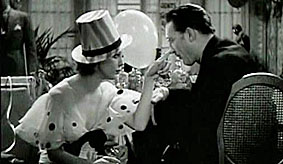
But they do anyway. Get married, that is, and in secret, which means that Madeline must continue to fend off Anderson’s advances, unsuccessfully so, which makes this a somewhat racy comedy as well as a serious romantic drama, one definitely made in the pre-Code era.
But getting back to Warren William, what he does so well is to play an utter cad, but one with good reasons for doing what he does. Deadwood should be replaced. Standing up to the bankers on the board of directors should be done; all they’re interested in the money coming in, with no effort on their part, at the expense of the workers Anderson would have to let go if he were to retrench and cut back as they advise him and as every other business is doing — and failing as a result.
Warren William makes us, the viewer admire, if not quite like him, even as we hate him. That’s a tough job for any actor to pull off, and William makes it look easy.
Mon 18 Jul 2016
TIMOTHY KNOX – Death in the State House. Houghton Mifflin, hardcover, 1934. Black Cat Detective #24, digest-sized paperback, 1946.
In the Capitol of an unnamed state — internal evidence suggests New Jersey — the Governor is working late. When someone inserts a knife in his neck. he stops working. Since the Governor is a womanizer, a gambler, and an owner of a “speak” and gambling den, he has lots of enemies.i
Called in to investigate is Eli Scott, apple grower and chief of police of a small town. Solving the murder is beyond the dubious talents of the capital city’s police since this is an impossible crime: Those who could have murdered the Governor all clear each other.
An only novel, interesting primarily because it’s a rather good impossible crime for the times.
Bibliographic Notes: Bill was quite correct in saying that this was Timothy Knox’s only novel. What he may not have known is that Knox was the pseudonym of Charles Fisher & Elizabeth K. Read, about either little is known. Fisher, however, was also the author of a short story collection entitled Some Unaccountable Exploits of Sherlock Holmes (1956; perhaps self-published).
Sun 17 Jul 2016
FORTY GUNS. 20th Century Fox, 1957. Barbara Stanwyck, Barry Sullivan, Dean Jagger, John Ericson, Gene Barry, Robert Dix. Director: Samuel Fuller.
Written, directed, and produced by Samuel Fuller, Forty Guns is an emotionally stormy, visually captivating “noir†Western. It’s one of those many mid-to-late 1950s Westerns with a script, had it been in the hands of a studio craftsman, would have produced just another generic movie about a gunman turned lawman facing off against a power hungry cattle baron. But in the hands of the Fuller, an auteur known for his work in Westerns and the war film genre, the movie rises above its recycled cinematic tropes and becomes something far more unconventional.
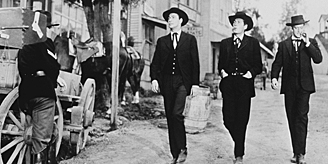
Filmed in Cinemascope in black and white and replete with extremely well-staged sequences, Forty Guns stars Barry Sullivan as Griff Bonnell, a gunfighter who realizes that his kind’s days are numbered. With the lawless frontier dying, Bonnell decides to become a lawman and signs up as a federal marshal in Cochise County, Arizona. Along for the ride – both figuratively and literally – are his two brothers: Wes (Gene Barry) and Chico (Robert Dix).
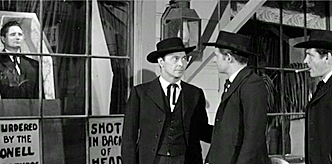
While Wes romances a local woman who just happens to be the daughter of the local gunsmith, Griff confronts with local cattle baroness Jessica Drummond (Barbara Stanwyck), a headstrong woman whose hotheaded brother Brockie is responsible for terrorizing the local townsfolk.
Although they are on opposite sides of the law, Griff and Jessica Drummond find themselves attracted to one another. Both know that they are the last of dying breed, strong willed people who have risen far above what the world expected from them. Any chance of rapprochement is forever shattered when Brockie murders Wes in cold blood on his wedding day.
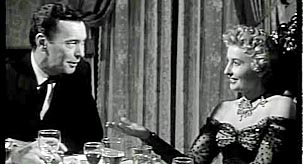
While there are some gritty action sequences, Forty Guns is a richly textured film overall. It’s a Western that’s also a Gothic romance, a drama rich in Freudian subtext, and an occasionally subversive take on the Western genre itself. Pulpy to the core, Fuller’s film doesn’t seem to have garnered the same critical attention as Anthony Mann’s grittier Westerns.
That’s unfortunate, particularly given how natural Barry Sullivan seems in his role as an aging gunfighter who, in the name of family loyalty, is willing to turn his back on what is perhaps his last chance at love and a normal life.
Sun 17 Jul 2016
JONATHAN GASH – The Lies of Fair Ladies. Lovejoy #15, St. Martin’s, hardcover, 1992. Penguin, paperback, 1993.
I’ve been more or less a fan of the Lovejoy series since it began, though I thought the last one (The Great California Game) was a total waste of paper. I approached this one with some caution, but hoping that a return to native shores would restore the series to something like normalcy.
For those new to the series, Lovejoy is an antique dealer, womanizer, and thoroughgoing rogue who lives only for antiques (women are more of a nuisance). He’s back home and his usual self, juggling a few lovers and on the lookout for the main chance. The plot is a hodgepodge of elements that all come together (after a fashion) in the end: a major antiques robbery, 17th century witch hunts, an apprentice who is the Mayor’s wife, and a popular radio announcer. To explain it coherently would overtax my power to synopsize briefly.
The main attractions of the series for me have always been the antique lore and the speech patterns of Lovejoy and his cronies. Those remain, but in the last few books the plots have seemed to me to be a little loose, and I suspect that I’m growing less fond of Lovejoy himself. The series may be wearing a little thin, but is still worth your time if you’re a fan.
Sat 16 Jul 2016
Available from Stark House Press, Amazon, Walmart and at PulpFest 2016.
Sat 16 Jul 2016
LOUIS L’AMOUR “Unguarded Moment.” First appeared in Popular Detective, March 1952. Collected in The Hills of Homicide (Bantam, paperback, 1983).
The first paragraph caught my attention:
The second really had me sitting up and taking notice:
And the third had me hooked all the way:
But of course he was seen, and therein lies the story. It continues with some petty blackmail, an accidental death, the dead man’s girl friend who wants to …
This is Cornell Woolrich territory, maybe with clearer and simpler language, but pure noir from beginning to end.
Fri 15 Jul 2016
TENSION. MGM, 1949. Richard Basehart, Audrey Totter, Cyd Charisse, Barry Sullivan, Lloyd Gough, William Conrad. Written by Alan Rivkin and John Klorer. Directed by John Berry.
A neat, twisty little noir that comes close to perfection.
Willard Quimby (Richard Basehart) starts out as the bespectacled night manager of an all-night L.A. drugstore, back in the days when every drugstore had a soda fountain, a tube-tester, a cigar humidor and the latest out-of-town newspapers. And I have to say right at the start that photographer Harry Stradling and art director Leonid Vasian make this place come alive with a wealth of detail captured in sharp, deep-focus photography: the perfect real-life backdrop for the characters who live in it.
We quickly learn that Willard’s wife Claire (Audrey Totter) seems to be trying for the title of Town Tramp in the Greater Los Angeles Metropolitan Area, blatantly cheating on him (with a surprising frankness for an MGM film of this period) and belittling him every chance she gets. Nonetheless, he loves her and reacts with dog-like devotion to every crumb of scorn she tosses at him.
Well we’ve all had relationships like that, haven’t we? But when she moves in with showy Barney Dauger (Lloyd Gough), Warren is devastated. Distraught, he shows up at Barney’s beach house and gets in a scuffle with Barney, who knees him in the crotch (another unexpected moment for a 1949 MGM movie) and leaves him writhing humiliated in the sand in front of his unfaithful wife.
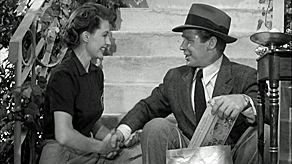
Someone said something clever once about a little man scorned, but I forget what it was. In any event, it prompts Willard to murder, and he conceives a brilliant/half-baked scheme to get away with it; he gets contact lenses and assumes a secret identity: Paul Sothern, a traveling salesman staying weekends at a nice apartment complex and occasionally phoning threats to Daeger, making sure to leave his name. His thinking is that when he-as-Sothern murders Daeger, Sothern can simply disappear, leaving him safe as Warren Quimby.
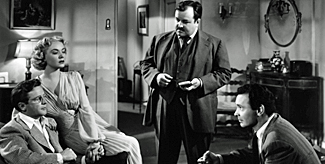
What he doesn’t count on is that his role as Paul Sothern will be much more enjoyable than his life as Quimby. He even meets a pretty neighbor (Cyd Charisse) at his new apartment complex, they feel drawn to each other, and for a while he considers just forgetting about the whole murder thing and making a good life with a nice girl who loves him. But then he remembers his humiliation and steels his resolve to throw away this chance for happiness and make a mess of things.
Which is when the twists and turns come in and things get interesting.

I won’t reveal anything from here on out, except to note that Tension proves to be a very apt title indeed. Barry Sullivan and William Conrad make an intriguing pair of homicide cops, especially as Sullivan seems more interested in putting the make on Audrey Totter than anything else. Writers Rivkin and Klorer provide a fair share of dramatic surprises, and director Berry maintains the atmosphere without sacrificing pace.
I should also add that a few minutes after THE END flashes on the screen and you smile with satisfaction, you may find yourself saying, “Hey, wait a minute; why did….?†Or “How come they didn’t…?†I know I did. But on looking back a third time I had to admit it all makes for engrossing viewing even when logic takes a holiday.
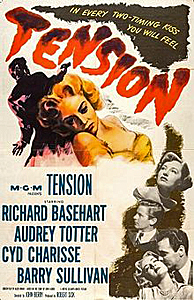
Fri 15 Jul 2016
AGATHA CHRISTIE – Murder at Christmas. Dodd Mead, hardcover, 1939. Originally published in the UK as Hercule Poirot’s Christmas (Collins, hardcover, 1939). Reprinted many times, including under the title A Holiday for Murder.
What could be a better book to read on a flight from Detroit to Los Angeles than a beat-up copy of an good old-fashioned Hercule Poirot murder mystery? None I can think of, I say, and that it’s a locked room mystery is only icing on the cake.
And why murder at Christmas? Let M Poirot tell us:

Dead with his throat cut is an old man who has been disappointed in his offspring and has told them just that only hours before. He also told them, with deliberate malice, that he intends to change his will immediately after Christmas. But does he live that long? You should know better than to ask.
Here’s the problem, though. The door to the dead man’s room is locked from the inside and must be broken down to get to him, and the windows do not open. The servants cannot have done it and there is no homicidal maniac on the loose anywhere around. It must be one of the family, but which one? And how?
Poirot claims the solution must come from the personalities of each of the possible suspects, and even more importantly that of the victim himself. How true! Any reader who dares to ignore such a challenge to the reader will make absolutely no headway in solving this case before Poirot does, and even then, only those readers who are already familiar with the tricks that Agatha Christie invariably had up her sleeve will stand a chance. As for myself, I have given up trying. To my mind, this is an amazing piece of work.
One thing still puzzles me though. The story does take place over the course of seven days between December 22nd through the 28th, but besides the gathering together of the old man’s sons and their wives, plus a surprise guest or two, there are no festivities planned, no grand meals, no decorations, no gifts, no snow, none of the usual Yuletide trappings. The story is fine without them, but I kind of missed them.